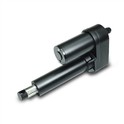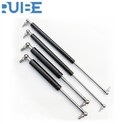When it comes to the world of linear actuators, two key players often take the spotlight: servo-driven and stepper-driven linear actuators. As a seasoned supplier of linear actuators, I've witnessed firsthand the unique characteristics and applications of each type. In this blog post, I'll delve into the differences between servo-driven and stepper-driven linear actuators, shedding light on their performance, cost, and suitability for various industries.
Understanding the Basics
Before we dive into the differences, let's briefly understand what servo-driven and stepper-driven linear actuators are. A linear actuator is a device that converts rotational motion into linear motion. Servo-driven linear actuators use a servo motor, which is a type of motor that can control the position, speed, and torque precisely. On the other hand, stepper-driven linear actuators use a stepper motor, which moves in discrete steps.
Performance
One of the most significant differences between servo-driven and stepper-driven linear actuators lies in their performance. Servo-driven linear actuators offer high precision and accuracy. They can maintain a constant speed even under varying loads, making them ideal for applications that require precise positioning. For example, in a robotic arm that needs to pick and place objects with high accuracy, a servo-driven linear actuator would be the perfect choice.
Stepper-driven linear actuators, while not as precise as servo-driven ones, still offer good accuracy for many applications. They are known for their ability to hold a position without the need for continuous power, which is a feature called "holding torque." This makes them suitable for applications where the actuator needs to maintain a fixed position for an extended period, such as in a 3D printer where the print head needs to stay in place during the printing process.
Speed and Torque
In terms of speed, servo-driven linear actuators generally have a higher maximum speed compared to stepper-driven ones. They can accelerate and decelerate quickly, allowing for rapid movements. This makes them suitable for high-speed applications, such as in packaging machines where products need to be moved quickly along the production line.
When it comes to torque, servo-driven linear actuators can provide high torque over a wide range of speeds. They can handle heavy loads and maintain a consistent performance even under challenging conditions. Stepper-driven linear actuators, on the other hand, have a limited torque range, especially at high speeds. Their torque output decreases as the speed increases, which can be a limiting factor in some applications.
Cost
Cost is always an important consideration when choosing a linear actuator. Servo-driven linear actuators are generally more expensive than stepper-driven ones. This is due to the complexity of the servo motor and the control system required to operate it. The servo motor needs a feedback device, such as an encoder, to provide information about the position and speed, which adds to the cost.
Stepper-driven linear actuators are more cost-effective, especially for applications where high precision and speed are not critical. They are simpler in design and do not require a feedback device, which makes them more affordable. However, it's important to note that the total cost of ownership should also include factors such as maintenance and energy consumption.
Applications
The choice between a servo-driven and a stepper-driven linear actuator depends largely on the application. Here are some common applications for each type:
Servo-driven Linear Actuators
- Robotics: As mentioned earlier, servo-driven linear actuators are widely used in robotic arms and other robotic applications that require precise positioning and high-speed movements.
- Automotive Industry: In automotive manufacturing, servo-driven linear actuators are used in various applications, such as in the assembly of engines and transmissions, where precise control is essential.
- Medical Equipment: Servo-driven linear actuators are used in medical devices, such as surgical robots and patient positioning systems, where high precision and reliability are crucial.
Stepper-driven Linear Actuators
- 3D Printing: Stepper-driven linear actuators are commonly used in 3D printers to control the movement of the print head and the build platform.
- CNC Machines: In computer numerical control (CNC) machines, stepper-driven linear actuators are used to control the movement of the cutting tool, providing good accuracy at a lower cost.
- Home Automation: Stepper-driven linear actuators are used in home automation systems, such as in Linear Actuator for Door Opener, Linear Actuator for Recliner Chair, and Linear Actuator for Electric Sofa, where cost-effectiveness and simplicity are important factors.
Conclusion
In conclusion, both servo-driven and stepper-driven linear actuators have their own unique advantages and disadvantages. Servo-driven linear actuators offer high precision, speed, and torque, but they come at a higher cost. Stepper-driven linear actuators are more cost-effective and suitable for applications where high precision is not critical.
As a supplier of linear actuators, I understand the importance of choosing the right actuator for your application. Whether you need a high-precision servo-driven linear actuator for a complex industrial application or a cost-effective stepper-driven linear actuator for a home automation project, I can provide you with the best solution. If you have any questions or need further information about our linear actuators, please feel free to contact us. We look forward to discussing your requirements and helping you find the perfect linear actuator for your needs.


References
- "Motion Control Basics" by Peter Nachtwey
- "Linear Actuators: Design and Selection Guide" by Thomson Industries






